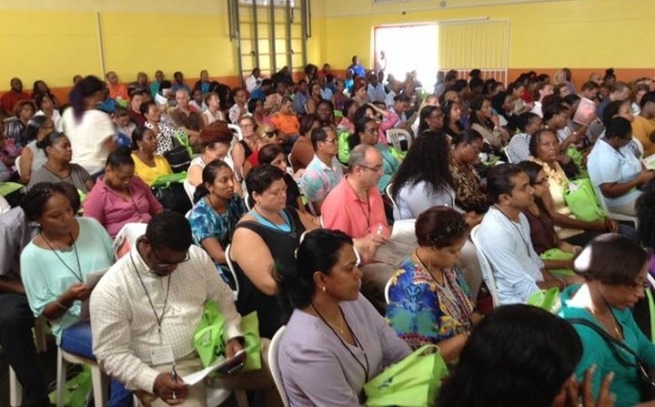~A kaleidoscope of technology in education~
CAY HILL – On October 23 through 25, the Hillside Christian School and the adjoining NIPA were the scene of a dazzling array of lectures and workshops on applying 21st century technology in education, constituting the second annual C-TEC conference.
Driven by the motto “Connecting Caribbean Classrooms and Communities” the Foresee Foundation organized its second annual conference with an audience including each and every educator in St. Maarten.
At the closing of the conference on Tuesday afternoon, the total number of participants stood at 1,004 persons; over 400 of them attended the Monday program when the secondary school educators were invited, and over 650 on Tuesday, when the program was geared towards primary school teachers. Significantly, some 40 Anguillan teachers and other professionals found their way to the conference, as well as 25 from the islands of the former Netherlands Antilles.
The turnout of this second C-TEC conference was more than 10% higher than last year’s edition, with 95% completing the on-line pre-registration. Both numbers are sound indicators of the enthusiasm of our educators for this event. Each of the 30 workshops on Monday and the 42 on Tuesday were very well attended, and the first impressions of the evaluations that were conducted in each session are resoundingly positive.
Workshop topics on both days ranged from practical demonstrations of technical tools to use in the classroom, or in homework assignments, to entirely new ways of transferring information to students using social media, and more importantly offering the young generation ways to explore knowledge by themselves. Concepts ranged from the modern yet well-known, like how to use an interactive whiteboard using different software tools, to outright revolutionary, like integrating gaming into the didactical approach, or learning by way of a Makerslab, where experiments have taken the place of traditional frontal teaching.
The conference also offered a range of topics on how educators can communicate with students and their parents using social media, tools to record grades and assignments and track the students’ progress, helpful technology for classroom management and school management systems.
The first conference day kicked off with a keynote address by Cheryl Peltier-Davis, a well-known Trinidad & Tobago-based “Web 2.0” expert. She is one of the leading Caribbean experts in the field of interactive web-based tools and the recent author of two seminal books on the subject. She took her audience on a journey through the five main trends that characterize the internet nowadays, and gave a futuristic view of what the internet – and the world of communication – might look like in 2020. Examples of this are wearable technology, which we already know in the form of smart bands, and the “internet of things” with a refrigerator that warns you – via your smartphone of course – when you are out of milk.
The second day was introduced by Steve Dembo, a U.S.-based specialist on the cutting edge of social media and education. With an engaging approach, Dembo walked the crowd through a simple modern mechanism of visual communication, namely the power of memes. The crowd laughed at how a simple picture and text could make your mind read a frame in surprisingly different ways. This, he pointed out, has expanded the many ways we communicate in the 21st century.
Dembo encouraged the 600 educators in attendance to log visual reminders of each day or step in the learning process, and refer to that picture or video with the students, as each student can communicate an entirely different memory from the same picture. If a picture is worth a thousand words, a meme may be worth a million. According to Dembo, you invent the future in your classroom by listening to the stories of your students. Digital media offers you the opportunities to personalize education, allowing each child to express and develop in his or her own way.
In addition to the keynote speeches and the regular workshops, dedicated spaces were reserved for a “Makers lab” and a Game Corner. In the past, computer games were strictly separated from education, even regarded with some reservation by the teaching community. However, “Gamification” has now become a buzzword in schools, signifying the acceptance and full integration of game-based technologies into the learning process.
C-TEC was fortunate to have Kreston Shirley, a prominent activist in the area where Gaming meets Education, as a featured speaker and an almost permanent guest in the Game Corner that was run by “For the Win Gaming,” the latest branch on the Foresee Foundation’s organizational tree.
The Makers lab showcased a new wave in education, where students work hands-on with technology to familiarize and learn in an experimental setting. The Makers Lab was running full time during the entire conference with contributions of, among others, the staff of the Philipsburg Jubilee Library. Feedback from participating teachers clearly indicated great interest in the Makerslab as well as the Game Room as integral parts of the conference.
Although the amount of information on offer was at times almost overwhelming, and the intensity of the program invited comparisons to a pressure cooker, on both days the teachers in attendance were unanimous in their positive assessment of the quality of the conference. The modern premises of Hillside Christian School (Asha Stevens Campus) together with the brand-new NIPA building were appreciated as a perfect venue for the conference.
Both schools are fully equipped with “Smartboards” in every classroom, which were fully and expertly used by the presenters. This gave most of the teaching community, some of whom were as yet unfamiliar with the full extent of this equipment’s possibilities, a first-hand impression.
Overall, hands-on sessions were clearly appreciated the most, in particular those by Gail Lovely, an educational technology expert who represented Houghton Mifflin Harcourt publishers. Among the policy-oriented workshops, those of Hodder Education’s Katie Mackenzie met with high acclaim.
An entire floor of the Hillside school was reserved for a full-fledged Business Exhibition, showcasing major local and international suppliers of technology and learning materials. All our top local technology and educational materials providers were present to ply their trade, from Boolchand’s and Klass electronics to van Caribwork, Dorp, Keijzer and Antek. Among the international businesses, Oxford University Press, Houghton Mifflin Hartcourt and Hodder Education deserve mentioning being major educational publishers for the Caribbean schools.
TelEm through its 100 Mb internet service together with UTS provided the conference with the required internet bandwidth, crucial for the success of a technology event of this scale.
The second edition of the C-TEC conference has again been made possible by the tireless efforts and tenacity of countless volunteers. However, it also has the backing and forceful cooperation of our key institutions like the Ministry of Education, Culture, Youth, and Sports and our National commission for UNESCO, with further key contributions from the Windsong International Foundation and many local and international sponsors.
The Foresee Foundation feels very grateful for all the positive feedback and thanks all participants, sponsors, presenters and last but not least its over 100 volunteers for their efforts and commitment. The Foundation is looking forward with confidence to more exciting future projects in the local and regional community.






























